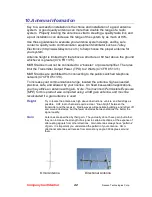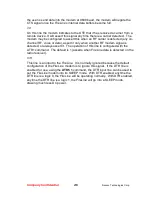
Company Confidential
38
Raveon Technologies Corp.
4. Adjust the frequency to the center of the channel with the
ATR8
command. You can use the “U” key and the “D” key to change the
settings up and down one value in real time.
8.4.
TX Deviation
1. Switch to channel 1.
2. Key the transmitter into a 50 ohm load using the
ATTD 5
command. The
unit will now transmit, and send a digital 0 continuously. This should be
+2.0kHz in frequency for narrow-band radios (12.5kHz spaced channels)
and +4.0kHz for wide-band (25kHz channels).
3. Adjust the deviation register setting so that the frequency deviation is
correct. The deviation is set with a digital adjustment. Use the ATR0
command to read or set the deviation level.
8.5.
TX Modulation Balance
(
Note: This step is not performed on radios with Radio Type 5
)
1. Set-up a service monitor to monitor the FM deviation of the transmitted
signal on an oscilloscope. The frequency response of the demodulated
FM signal must be greater than 10Hz to 5kHz without any de-emphasis.
2. Transmit random data with the
FireLine
, using the
ATDT 1
command.
This command will cause the
FireLine
to automatically key up, and send
random data for one minute.
3. Verify the DC center of the demodulated data is stable. The random data
should be randomly timed 1s and 0s, and have little to no AC component
on them. See pictures below for details.
4. If necessary, change the
ATR9
setting so that the long data bit have the
same amplitude and DC value as the shorter ones.
8.6.
RX DC Offset Verification
To verify that the DC center of the received signal is near the nominal value,
perform the following steps:
1. Generate a test signal, 1kHz tone, 1.5kHz deviation, on the receive
frequency. Connect the signal generator to the antenna input. Set the RF
level to -90dBm.
2. Measure the average voltage at TPRX1 on the modem circuit board.
3. The DC voltage should be between 1.0 and 2.0 volts, and the p-p voltage of
the sine wave should be greater than 50mV and the DC bias on the signal
should be less than 2 volts DC.
4. There is no calibration required in this step, but if the specification is not meet,
the “quad” coil in the radio may need adjustment to pull the DC level into
spec.





























